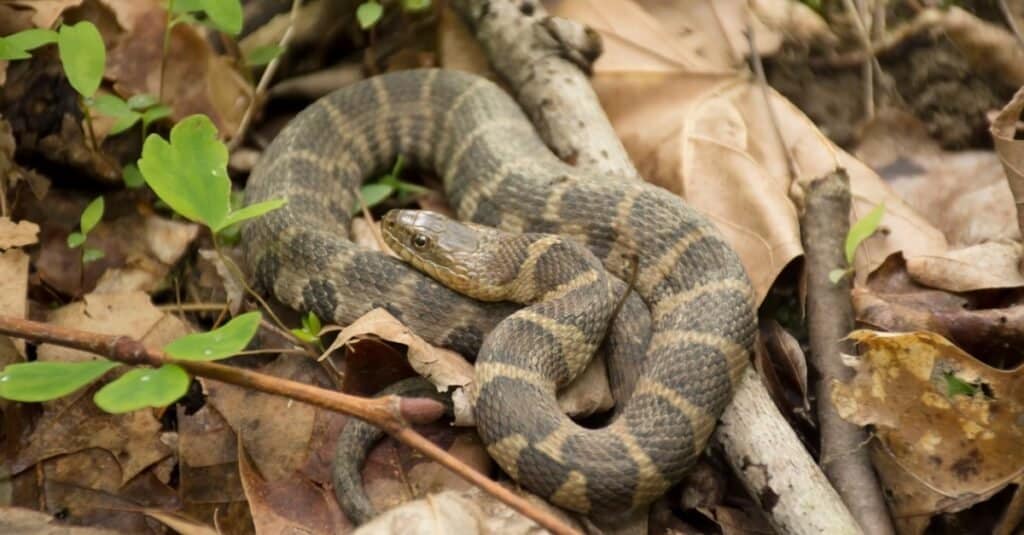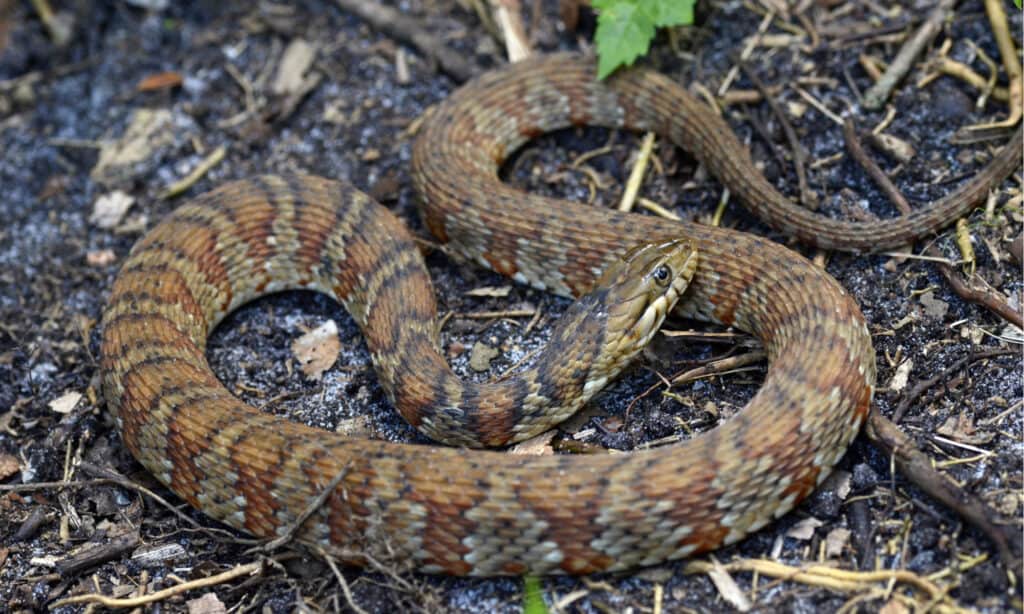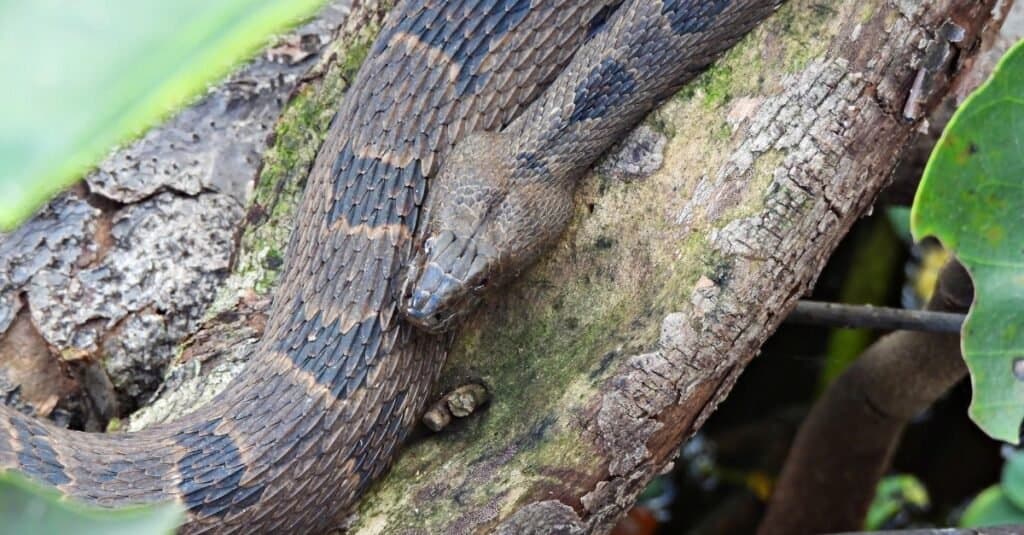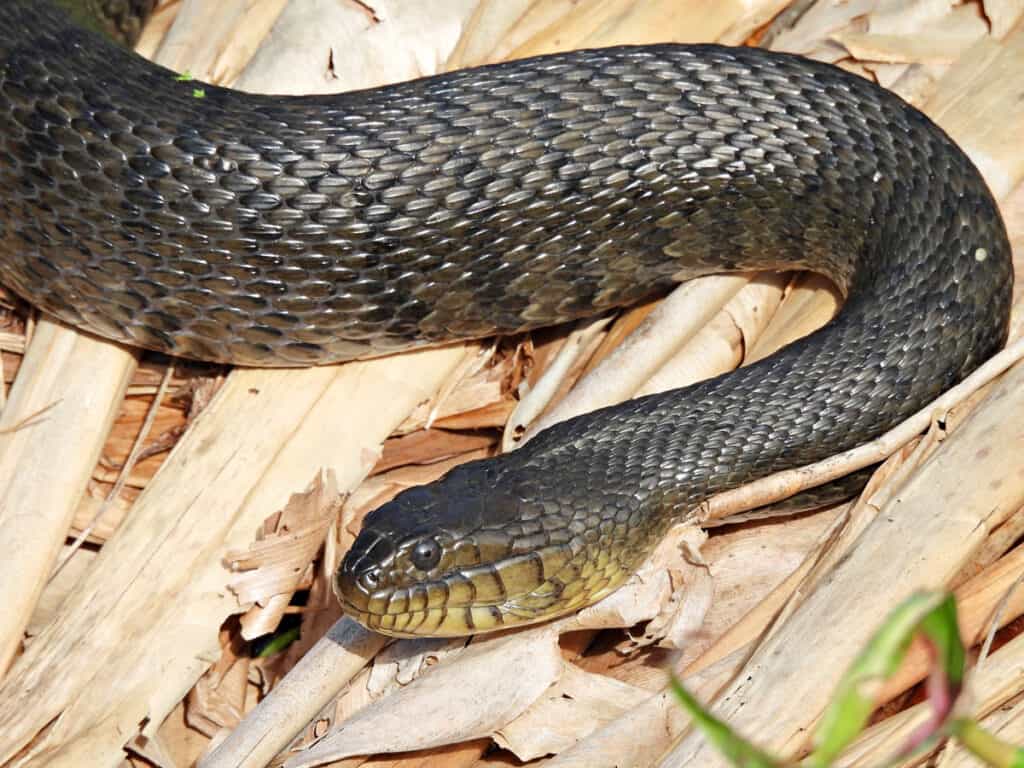5 Water Snakes In South Carolina
#mobileSnakeQuizControls { overflow: hidden; text-overflow: ellipsis; white-space: nowrap; }
@media (min-width: 481px) {
.mobile-top-content {
display: none;
}
}
#mobileTopContentCTACarouselControls { overflow: hidden; text-overflow: ellipsis; white-space: nowrap; }
.mobile-top-content .more { color: #fff; }
.mobile-top-content a { color: #fff; text-decoration: underline; }
.mobile-top-content a:hover { color: #fff; text-decoration: underline; }
@media (max-width: 480px) {
.mobile-top-content {
background-color: #06a10b;
color: #fff;
text-align: center;
/*height: 60px;
padding-top:5px;*/
font-size:80%;
/* display: block; */
margin: 0px -30px;
}
}
South Carolina is a southeastern state of the United States which has some incredible habitats that are home to many wonderful animals. From the rugged Blue Ridge Mountains to the Piedmont plateau to miles upon miles of stunning rivers, there is something for everyone. However, some of the most interesting animals are water snakes. Water snakes are semi-aquatic snakes from the genus Nerodia. There are nine species across North America, five of them are found in South Carolina. Although many other snakes also inhabit water – such as swamp snakes and venomous cottonmouths – only snakes from Nerodia are classed as true water snakes. So join us as we learn all about the water snakes in South Carolina!
Northern Water Snake

iStock.com/IcemanJ
Also known as the common water snake, northern water snakes are large snakes that can reach lengths of up to 54 inches, with females being larger than males. There are currently four subspecies – Lake Erie water snake, midland water snake, Carolina water snake, and the northern water snake (the nominotypical subspecies). Northern water snakes (Nerodia sipedon) are brown or brownish-black with crossband markings on their neck and blotches on their bodies. Due to their appearance, they are regularly mistaken for venomous cottonmouths – something that often results in many of them being wrongly killed. Although northern water snakes can give a nasty bite if they are cornered or threatened, they are not venomous and pose no real threat to humans.
button.pulse {
transform: scale(1); animation: pulse 2s infinite;
box-shadow: 0 0 0 0 rgba(11, 247, 25, 1);
}
@keyframes pulse {
0% { transform: scale(0.90); box-shadow: 0 0 0 0 rgba(11, 247, 25, 0.5); }
60% { transform: scale(1); box-shadow: 0 0 0 15px rgba(11, 247, 25, 0); }
100% { transform: scale(0.90); box-shadow: 0 0 0 0 rgba(11, 247, 25, 0); }
}
Northern water snakes are ovoviviparous. This means that embryos develop in eggs inside the female until they are ready to hatch and subsequently give birth to live young. Newborns are left to fend for themselves after birth as the female does not look after them. Northern water snakes always live in permanent water sources – such as streams, rivers, lakes, and swamps. They are often seen basking in the sun near the shore, but quickly flee back into the water at the first sign of danger. Northern water snakes eat a range of animals from both in and out of the water – such as fish, amphibians, birds, and small mammals.
Banded Water Snake

Patrick K. Campbell/Shutterstock.com
Another water snake in South Carolina is the banded water snake. Banded water snakes (Nerodia fasciata) are 24 to 48 inches long and have flat heads and keeled scales on their back. They are typically brown, gray, or greenish-gray with dark cross band markings, hence their name. There are currently three recognized subspecies – broad-banded water snakes, Florida banded water snakes, and southern watersnakes.
Banded water snakes live in shallow freshwater habitats, with ponds, streams, and swamps being preferred. They are viviparous and give birth to live young, 8 to 9 inches long at birth. Banded water snakes are able to crossbreed with northern water snakes to produce hybrid offspring, although this doesn’t happen that often. They are most active at night and usually feed on fish and frogs, which are swallowed whole. However, they can often be seen basking during the day, although they rarely ever stray far from the safety of the water or the shore. Predators of banded water snakes include alligators, birds of prey, and larger snakes.
Brown Water Snake

iStock.com/passion4nature
One of the most common water snakes in North America is the brown water snake. Brown water snakes (Nerodia taxispilota) are large snakes at 30 to 60 inches long. They are brown with large dark blotches down their back and smaller ones down their sides. Although they have thick, heavy bodies, their necks are distinctly narrower than their heads. Brown water snakes live in rivers, streams, and swamps in low coastal regions. However, they are also excellent climbers and can climb as high as 20 feet up trees. They sometimes even mate on the branches too! Brown water snakes are ovoviviparous, and newborns are 7 to 10 inches long when they are born. Interestingly, juveniles males are longer than females – which is the opposite of them as adults.
Like many other water snakes, brown water snakes are often mistaken for venomous cottonmouth snakes. They are also even known as false moccasins as a nod to this (as cottonmouths are known as water moccasins). However, like all true water snakes, brown water snakes are not venomous and are not harmful to humans. Although they can bite if threatened, they usually prefer to flee back into the safety of the water.
Florida Green Water Snake

iStock.com/passion4nature
Despite their name suggesting otherwise, Florida green water snakes are also found in South Carolina. Florida green water snakes (Nerodia floridana) are the longest water snakes in North America and are 30 to 55 inches long, with a record of 74 inches. They are usually greenish-brown with dark speckles on their dorsal side and have yellow or cream bellies. They also have several small scales underneath their eyes – a trait that is shared only with green water snakes. Florida green water snakes were originally thought to be a subspecies of green water snakes. However, they are now classed as their own separate species.
Florida green water snakes prefer calm water such as swamps, lakes, and ponds in areas where there is plenty of vegetation. They are active throughout most of the year but hibernate during the winter in the coldest regions. Florida green water snakes give birth to some of the largest litters – often up to 40. However, as a result, very few of them reach adulthood.
Plain-Bellied Water Snake

/Shutterstock.com
The final water snake in South Carolina is the plain-bellied water snake. Plain-bellied water snakes (Nerodia erythrogaster) are 24 to 40 inches long. They are typically brown, green, gray, or black on their dorsal side. However, their bellies are either reddish-orange or yellow without any markings, which is why they are called “plain-bellied.” They also have keeled scales on their backs which creates a rough ridge.
Plain-bellied water snakes live in freshwater habitats such as rivers, lakes, swamps, and streams. However, although they are true water snakes, they spend much more time out of the water than other snakes do. They also tend to flee across the land rather than into the water when threatened. Plain-bellied water snakes spend large parts of their day basking in the sun on logs and rocks. They are not venomous, but when threatened, they release a foul-smelling musk to try and deter any predators. Despite this, they do have a lot of predators, which include kingsnakes and cottonmouths.
Discover the “Monster” Snake 5X Bigger than an Anaconda
Every day A-Z Animals sends out some of the most incredible facts in the world from our free newsletter. Want to discover the 10 most beautiful snakes in the world, a “snake island” where you’re never more than 3 feet from danger, or a “monster” snake 5X larger than an anaconda? Then sign up right now and you’ll start receiving our daily newsletter absolutely free.
More from A-Z Animals
.more-snake-card-image { max-height:140px !important; }
#mobileSnakeQuizControls { overflow: hidden; text-overflow: ellipsis; white-space: nowrap; }
@media (min-width: 481px) {
.mobile-top-content {
display: none;
}
}
#mobileTopContentCTACarouselControls { overflow: hidden; text-overflow: ellipsis; white-space: nowrap; }
.mobile-top-content .more { color: #fff; }
.mobile-top-content a { color: #fff; text-decoration: underline; }
.mobile-top-content a:hover { color: #fff; text-decoration: underline; }
@media (max-width: 480px) {
.mobile-top-content {
background-color: #06a10b;
color: #fff;
text-align: center;
/*height: 60px;
padding-top:5px;*/
font-size:80%;
/* display: block; */
margin: 0px -30px;
}
}
South Carolina is a southeastern state of the United States which has some incredible habitats that are home to many wonderful animals. From the rugged Blue Ridge Mountains to the Piedmont plateau to miles upon miles of stunning rivers, there is something for everyone. However, some of the most interesting animals are water snakes. Water snakes are semi-aquatic snakes from the genus Nerodia. There are nine species across North America, five of them are found in South Carolina. Although many other snakes also inhabit water – such as swamp snakes and venomous cottonmouths – only snakes from Nerodia are classed as true water snakes. So join us as we learn all about the water snakes in South Carolina!
Northern Water Snake

iStock.com/IcemanJ
Also known as the common water snake, northern water snakes are large snakes that can reach lengths of up to 54 inches, with females being larger than males. There are currently four subspecies – Lake Erie water snake, midland water snake, Carolina water snake, and the northern water snake (the nominotypical subspecies). Northern water snakes (Nerodia sipedon) are brown or brownish-black with crossband markings on their neck and blotches on their bodies. Due to their appearance, they are regularly mistaken for venomous cottonmouths – something that often results in many of them being wrongly killed. Although northern water snakes can give a nasty bite if they are cornered or threatened, they are not venomous and pose no real threat to humans.
button.pulse {
transform: scale(1); animation: pulse 2s infinite;
box-shadow: 0 0 0 0 rgba(11, 247, 25, 1);
}
@keyframes pulse {
0% { transform: scale(0.90); box-shadow: 0 0 0 0 rgba(11, 247, 25, 0.5); }
60% { transform: scale(1); box-shadow: 0 0 0 15px rgba(11, 247, 25, 0); }
100% { transform: scale(0.90); box-shadow: 0 0 0 0 rgba(11, 247, 25, 0); }
}
Northern water snakes are ovoviviparous. This means that embryos develop in eggs inside the female until they are ready to hatch and subsequently give birth to live young. Newborns are left to fend for themselves after birth as the female does not look after them. Northern water snakes always live in permanent water sources – such as streams, rivers, lakes, and swamps. They are often seen basking in the sun near the shore, but quickly flee back into the water at the first sign of danger. Northern water snakes eat a range of animals from both in and out of the water – such as fish, amphibians, birds, and small mammals.
Banded Water Snake

Patrick K. Campbell/Shutterstock.com
Another water snake in South Carolina is the banded water snake. Banded water snakes (Nerodia fasciata) are 24 to 48 inches long and have flat heads and keeled scales on their back. They are typically brown, gray, or greenish-gray with dark cross band markings, hence their name. There are currently three recognized subspecies – broad-banded water snakes, Florida banded water snakes, and southern watersnakes.
Banded water snakes live in shallow freshwater habitats, with ponds, streams, and swamps being preferred. They are viviparous and give birth to live young, 8 to 9 inches long at birth. Banded water snakes are able to crossbreed with northern water snakes to produce hybrid offspring, although this doesn’t happen that often. They are most active at night and usually feed on fish and frogs, which are swallowed whole. However, they can often be seen basking during the day, although they rarely ever stray far from the safety of the water or the shore. Predators of banded water snakes include alligators, birds of prey, and larger snakes.
Brown Water Snake

iStock.com/passion4nature
One of the most common water snakes in North America is the brown water snake. Brown water snakes (Nerodia taxispilota) are large snakes at 30 to 60 inches long. They are brown with large dark blotches down their back and smaller ones down their sides. Although they have thick, heavy bodies, their necks are distinctly narrower than their heads. Brown water snakes live in rivers, streams, and swamps in low coastal regions. However, they are also excellent climbers and can climb as high as 20 feet up trees. They sometimes even mate on the branches too! Brown water snakes are ovoviviparous, and newborns are 7 to 10 inches long when they are born. Interestingly, juveniles males are longer than females – which is the opposite of them as adults.
Like many other water snakes, brown water snakes are often mistaken for venomous cottonmouth snakes. They are also even known as false moccasins as a nod to this (as cottonmouths are known as water moccasins). However, like all true water snakes, brown water snakes are not venomous and are not harmful to humans. Although they can bite if threatened, they usually prefer to flee back into the safety of the water.
Florida Green Water Snake

iStock.com/passion4nature
Despite their name suggesting otherwise, Florida green water snakes are also found in South Carolina. Florida green water snakes (Nerodia floridana) are the longest water snakes in North America and are 30 to 55 inches long, with a record of 74 inches. They are usually greenish-brown with dark speckles on their dorsal side and have yellow or cream bellies. They also have several small scales underneath their eyes – a trait that is shared only with green water snakes. Florida green water snakes were originally thought to be a subspecies of green water snakes. However, they are now classed as their own separate species.
Florida green water snakes prefer calm water such as swamps, lakes, and ponds in areas where there is plenty of vegetation. They are active throughout most of the year but hibernate during the winter in the coldest regions. Florida green water snakes give birth to some of the largest litters – often up to 40. However, as a result, very few of them reach adulthood.
Plain-Bellied Water Snake

/Shutterstock.com
The final water snake in South Carolina is the plain-bellied water snake. Plain-bellied water snakes (Nerodia erythrogaster) are 24 to 40 inches long. They are typically brown, green, gray, or black on their dorsal side. However, their bellies are either reddish-orange or yellow without any markings, which is why they are called “plain-bellied.” They also have keeled scales on their backs which creates a rough ridge.
Plain-bellied water snakes live in freshwater habitats such as rivers, lakes, swamps, and streams. However, although they are true water snakes, they spend much more time out of the water than other snakes do. They also tend to flee across the land rather than into the water when threatened. Plain-bellied water snakes spend large parts of their day basking in the sun on logs and rocks. They are not venomous, but when threatened, they release a foul-smelling musk to try and deter any predators. Despite this, they do have a lot of predators, which include kingsnakes and cottonmouths.
Discover the “Monster” Snake 5X Bigger than an Anaconda
Every day A-Z Animals sends out some of the most incredible facts in the world from our free newsletter. Want to discover the 10 most beautiful snakes in the world, a “snake island” where you’re never more than 3 feet from danger, or a “monster” snake 5X larger than an anaconda? Then sign up right now and you’ll start receiving our daily newsletter absolutely free.







